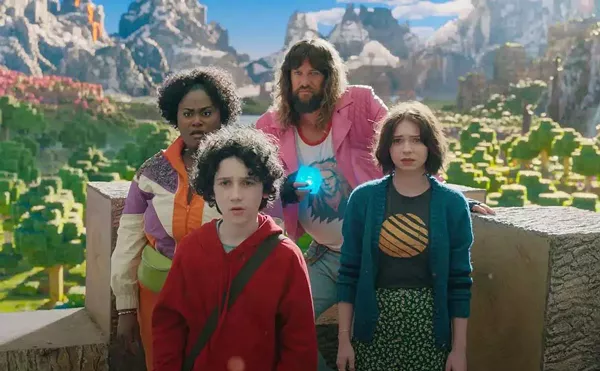As the drumbeats for war against Iran intensify, the question arises, where can we discover truths about that far-off land? From Ari Fleischer and the pro-war moneybags at Freedom's Watch? From Dana Perino?
Get real.
Better to gather input from Iranians, an option now auspiciously at hand in an eye-opening exhibit, Persian Visions: Contemporary Photography from Iran at the University of Michigan Museum of Art through Dec. 30. Instructive and often visually stunning, the traveling show of photos is the first of its kind to be circulated in this country since the Iranian Revolution of 1979.
Credit for organizing Persian Visions goes to Hamid Severi of the Tehran Museum of Contemporary Art and Gary Hallman of the Regis Center for Art at the University of Minnesota. In all, the exhibit comprises some 80 works — besides still photographs, a video and a film — by 20 Iranian artists.
The participating artists share a rich and commanding history, capped unhappily in recent decades by a repressive cultural revolution and the Iran-Iraq war. Yet far from isolation, artworks assembled in Persian Visions evidence absorption of outside influences — active embraces of new technologies and ideas. Like Iran itself, the artists confront modernity. That they also face stringent censorship (nudity is forbidden, as is critiquing the political regime) explains the engaging, elusive character of many works on view.
No work combines old and new more straightforwardly yet poetically than Sadegh Tirafkan's mixed-media "Persepolis," comprising still photographs flanked by monitors displaying videos. Storied Persepolis was the ceremonial capital of the Achaemenid Persian Empire (559 B.C.-330 B.C.), the second Iranian dynasty. Today, the archaeological site is a potent symbol of national pride.
In Tirafkan's pictures, striding figures are powerful vertical elements rhyming with freestanding, background columns. Yet while two male figures move about freely in Western clothes, a woman wears a confining chador, and, enveloped in it, more convincingly echoes one of the extant columns.
International influences also mark works by Ahmed Nateghi and Mehran Mohajer. Nateghi's digitally manipulated collages combine images clipped from glossy magazines. His slick, black-and-white compositions are products of western technology but are meant to criticize U.S. materialism.
Color photos in Mohajer's "T.V. Series" address a frequently and forcefully debated international issue: the nature of truth as disseminated by the mass media. Mohajer's photographic subjects are venerable-looking written texts, re-created electronically on a malfunctioning television screen.
Many of the photos are sympathetic portraits that cast into appalling light the recent statement, "I hate all Iranians," reportedly made by foreign policy advisor Debra Cagan, addressing visiting British MPs at the Pentagon. The odiousness of the remark is heightened by the sensitivity of Shahriar Tavakoli's portfolio "My Family." His striking color photos are of gentle, contemplative people no observer with a heart could hate.
Sympathetic too are vintage family portraits arranged in grids by Farshid Azarang, and faces of soldiers as photographed by Mohammad Farnood. Among Azarang's portraits are head shots of teenagers such as might appear in American high school yearbooks. Farnood's "Survival," from the period of the Iran-Iraq war, portrays a young soldier with a bandaged head and a blood-caked face.
Other portraits are less direct, raising questions about what can and can't be shown and suggesting that the veil, as Robert Silberman notes in the exhibit's catalog, is the central element in many works. Self-portraits by Shokoufeh Alidousti (one of two women represented in the exhibit) include just a sliver of the artist's face, otherwise hidden by a black background's "veil." At the base of each portrait, Alidousti's exposed fingers clutch a childhood or family photo, testifying to her fuller identity.
A more dramatic examination of restraints occurs in Bahman Jalali's "Images of Imagination." These are vintage studio portraits overspread with what appear to be loose, gestural brushstrokes in the manner of abstract expressionism. In fact, the strokes are marks of censure made by hard-line Islamists, inveighing against the act of making representations.
In other works too, artists recognize and address censorship. However, they often devise clever strategies for evading it, Silberman's essay asserts. Many pictures include bold areas of saturated or nearly saturated black. That's particularly true of silhouetted figures seen in photos by Majid Koorang Beheshti and Koroush Adim. In these and other works, areas of black hover ambiguously between representation and abstraction, eluding the culture police.
The exhibit's most commanding work, an eight-minute film "The White Station" by Seifollah Samadian, can also be read metaphorically. What the film portrays is a lone woman awaiting a bus in a violent snowstorm. Her plight may be understood broadly as symbolizing life's hardships in contemporary Iran. Subtlety and much else is showcased in Persian Visions, which offers a truer, more nuanced picture of Iran than has been coming from Washington.
Persian Visions runs through Dec. 30 at University of Michigan Museum of Art's temporary Off/Site location, 1301 S. University Ave., Ann Arbor; 734-764-0395 or umma.umich.edu.
Roger Green writes about art for Metro Times. Send comments to letters@metrotimes.com





